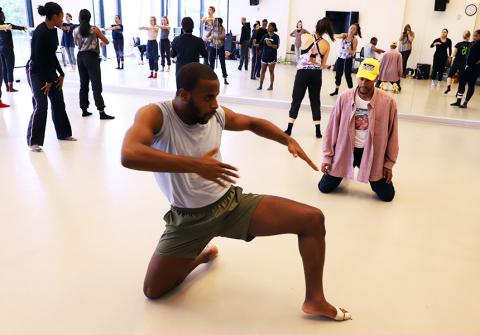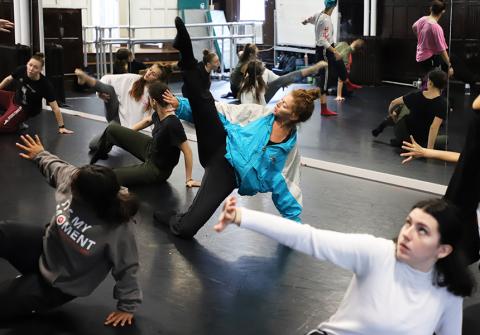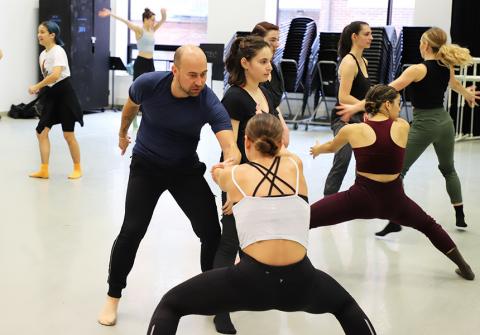Conservatory Dancers and Guest Artists Collaborate on World Premieres for From the Ground Up

Choreographer Juel D. Lane works with Conservatory dance student Dylan Contreras (B.F.A. '20) on Lane's work “con・ver・sa・tion・s.”
“This is a no-judgement zone; it’s like going to Planet Fitness,” jokes Juel D. Lane in the third-floor rehearsal studio at 31 Hemenway Street. This is Lane’s first of two weeks as a guest choreographer commissioned to create a new work for Boston Conservatory at Berklee’s annual Dance Division fall showcase, From the Ground Up, taking place October 31 to November 3.
After spending several days introducing students to his intricate choreography, he now asks them to speak out loud as they rehearse. The dancers, members of the Conservatory’s senior class, laugh as they tentatively let out gasps, shouts, and nonsense words to the rhythm of their steps. As they gain confidence and volume, their movements begin to take on a smooth, powerful quality. As their whole bodies become engaged and coordinated, and it is easy to see the value of the unusual assignment. For Lane, freedom in dance is about being willing to take risks, to stretch yourself to your limits.
In a sense, this idea embodies the entire piece, entitled “con・ver・sa・tion・s.” Lane, an active performer with Camille A. Brown & Dancers and a sought-after young choreographer commissioned by such renowned companies as Atlanta Ballet and Ailey II, is known for his high-energy, fast work. But his confidence belies an anxiety that has plagued him since childhood. This piece is his homage to abandoning fear; it is about “stepping into your light” and owning your space. The music has a sweeping, orchestral quality, and the choreography is equally energized and expansive. “When you hear your calling,” Lane says, “you have to answer.”
Several floors below, dance artist Zoe Scofield watches as another group of seniors splits into duos and trios. She has given them a set of precise choreography along with instructions to “orbit” within an arm’s length of one another, and has set them free to compose their own work within these parameters. “Don’t think or plan,” she tells them—just “let the material feed the research” organically. The variety of movement and range of emotional quality that emerges are stunningly creative and powerful.
Scofield, a 2015 Guggenheim Fellow for Choreography and coartistic director of zoe | juniper, a Seattle-based experimental dance and visual arts team, says that the piece, titled “This mountain (ordinary grief),” is typical of her work. It is a “constellation of ideas” rather than a linear narrative, Scofield explains. Influenced partially by her own divorce, the piece probes the isolation and fear that accompanies change, and explores the feeling of being alone within a group of people. Starting with this concept and a collection of related movements, Scofield came into rehearsal ready to respond to this specific group of dancers, allowing the process to inspire and shape her aesthetic.

This true collaborative approach is relatively rare, says Joy Davis, associate professor of contemporary dance and Scofield’s rehearsal director. Unlike many guest artists, Scofield’s approach is 50/50,. “I’ve been impressed with how well trained the dancers are, not only technically but with their ability to improvise and be responsive,” Scofield says.
Award-winning New York City-based choreographer Loni Landon also values meeting students halfway in the rehearsal studio. She is the cofounder of the Playground, an initiative aimed at allowing artists to experiment and create in open spaces. Her From the Ground Up commission, “Collide,” was inspired by Daniel Rozin’s art installation “Penguins Mirror,” which explores the creation of images and architecture through movement. “My goal was to translate the rippling and unfolding effect of the installation onto moving bodies and unlock visual possibilities,” she explains. “Similar to a constellation of stars—a Milky Way—we see the migration of bodies falling away and finding each other again.” Though she came into rehearsals with this sketch, she emphasizes that experimentation and trial and error are critical to her process. Like Scofield, she approached the dancers with choreography and parameters, but expected their artistic input, flexibility, and willingness to experiment.

Each guest choreographer’s approach and aesthetic are unique, yet they all aim to guide the dancers through the transitional space between student and professional. The world of professional dance is increasingly defined by collaboration, and the ability of a dancer to be an active participant in the creative process could make or break their career. They must learn how and when to ask questions and offer suggestions, take initiative to retain and shape material they are given, and perhaps most importantly, to absorb criticism graciously. Through this work, Conservatory students are developing their identities as artists, ready to present a new, mature version of themselves to their audience.

The world premieres of these newly commissioned pieces are just a glimpse of the rich program awaiting audiences at From the Ground Up performances. This year’s showcase will also feature “Parler un langues,” a world premiere by Bradley Shelver, principal dancer with the Metropolitan Opera Ballet, whose choreographic work has recently been commissioned by Ailey II and Richmond Ballet. The program will also premiere two exciting new works by dance faculty: Ruka Hatua-Saar White’s “Babbel,” and Daniel Pelzig’s “Heaven Is Under Our Feet,” dedicated to the memory of former Conservatory President Richard Ortner.
Boston Conservatory at Berklee will present From the Ground Up from Thursday, October 31 through Sunday, November 3 at Boston Conservatory Theater. Learn more and purchase tickets.
